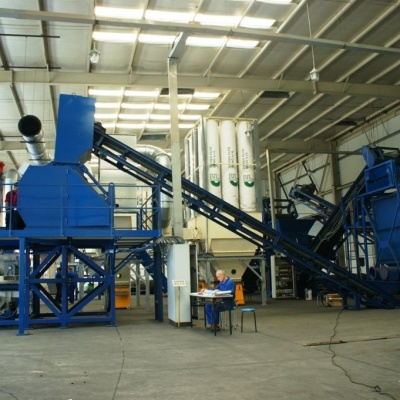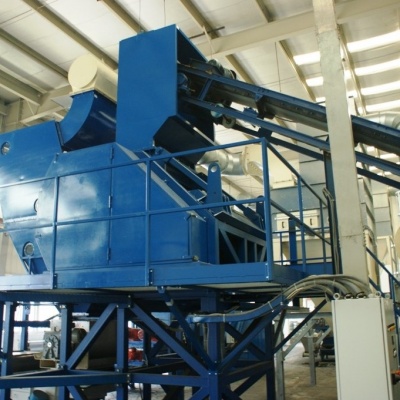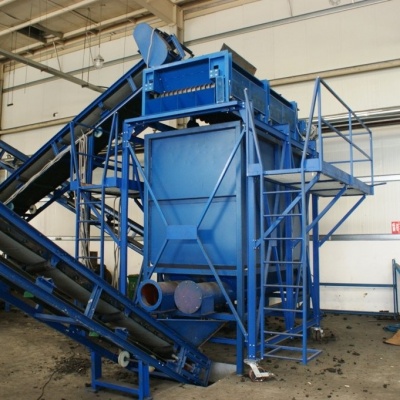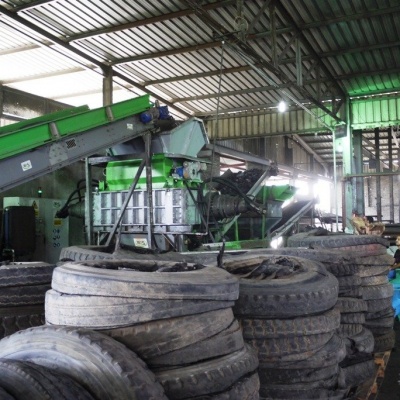Tire recycling line
Features
The tire recycling line is used to produce clean rubber granulate (mostly 1 - 4 mm) from tires. It is a relatively complex technological line consisting of crushing machines, separators, conveyors and air conditioning. Rubber granulate is used for the production of rubber products (sports surfaces, pavements, etc.) or as an admixture in the construction industry (asphalt, concrete, etc.)
We supply lines with a capacity of 500 kg/hour to 5,000 kg/hour.
Composition of the line:
The line can be divided into four technological parts:
Shredding into scraps approx. 50-100 x 50-100 mm
Grinding into cc 20 x 20 mm
Fine crushing into crumbs (granules) 1-4 mm
Cleaning of rubber granulate
A simple description of the line with a capacity of 3 t/h:
The tires are dosed by a chain belt conveyor into the SCE-1300 -150 kW tire shredder specially designed for tire shredding. Details of the tire shredder can be found here
The scraps goes on to a star sieve, which classifies it to a size of approx. 50 x 50 mm. Pieces of pre-shredded tires that are larger than the set mesh gap go back through the return branch to the shredder. Conforming pieces continue onto the exit conveyor.
Sraps from shredding are transported by conveyor to the storage tank. It can remove peaks and unevenness from shredding and doses a precisely set hourly amount to the GH 600/1200 200 kW mill. The storage tank is not required in the line, but we recommend it. If it is removed, the price will be reduced. It is then necessary to monitor the amount of grit in the hopper of the GH mill.
The GH 600/1200 mill is equipped with a 25-30 mm sieve. The exit from the mill is pneumatic-mechanical. When grinding on this type of mill, the rubber is separated from the steel. The first magnetic separator is behind this mill. After separation there is approx. 1-3% metal in the rubber. Details on the GH 600/1200 mill can be found here .
The separated metal with rubber remains is transported by a stainless steel belt conveyor to the designated place.
After magnetic separation the rubber crumbs go into the first G 600/1200 knife mill. Due to the Fe content in the rubber, this mill has knives made of a special tool steel, which is capable of crushing this mixture without any problems. As with the GH mill, the mill will be equipped with armoring of problematic areas. Details on the G 600/1200 mill can be found here
The output from the mill is pneumatic-mechanical by pneumatic transport. The blower has an input power of 30 kW. Behind this mill is the second mg. separation and to the first separation of the textile.
The rubber crumbs goe into the second G 600/1200 mill with a 4 mm sieve. The output from the mill is pneumatic-mechanical by pneumatic transport. The blower has an input power of 30 kW. A third mg. separation is behind this mill and the second textile separation.
Final cleaning of the textile from the granulate takes place on vibrofluidic tables.
Final cleaning is recommended when a highly pure granulate is required. The set-up provides for the final cleaning of 2.5 t of granulate per hour. It can be delivered later if necessary and only for the required amount of granulate per hour.
Technical parameters
| Motor/power | 500 - 2 000 kW |
|---|---|
| Throughput | 500 - 5 000 kg/h |
| Lenght | 20 000 - 45 000 mm |
| Width | 10 000 - 18 000 mm |
| Height | 8 000 mm |








